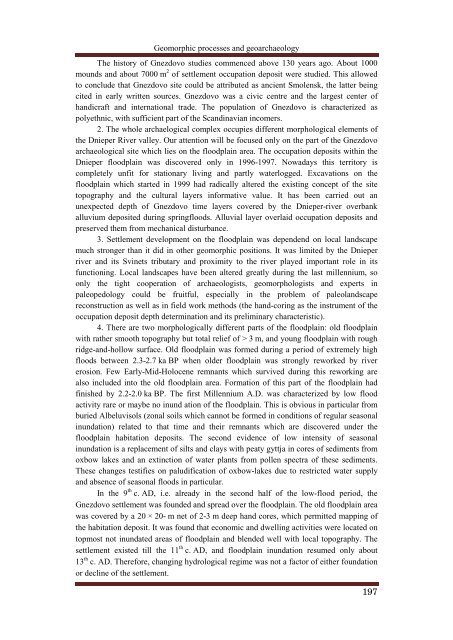extended abstracts - Geomorphic Processes and Geoarchaeology
extended abstracts - Geomorphic Processes and Geoarchaeology
extended abstracts - Geomorphic Processes and Geoarchaeology
Create successful ePaper yourself
Turn your PDF publications into a flip-book with our unique Google optimized e-Paper software.
<strong>Geomorphic</strong> processes <strong>and</strong> geoarchaeology<br />
The history of Gnezdovo studies commenced above 130 years ago. About 1000<br />
mounds <strong>and</strong> about 7000 m 2 of settlement occupation deposit were studied. This allowed<br />
to conclude that Gnezdovo site could be attributed as ancient Smolensk, the latter being<br />
cited in early written sources. Gnezdovo was a civic centre <strong>and</strong> the largest center of<br />
h<strong>and</strong>icraft <strong>and</strong> international trade. The population of Gnezdovo is characterized as<br />
polyethnic, with sufficient part of the Sc<strong>and</strong>inavian incomers.<br />
2. The whole archaelogical complex occupies different morphological elements of<br />
the Dnieper River valley. Our attention will be focused only on the part of the Gnezdovo<br />
archaeological site which lies on the floodplain area. The occupation deposits within the<br />
Dnieper floodplain was discovered only in 1996-1997. Nowadays this territory is<br />
completely unfit for stationary living <strong>and</strong> partly waterlogged. Excavations on the<br />
floodplain which started in 1999 had radically altered the existing concept of the site<br />
topography <strong>and</strong> the cultural layers informative value. It has been carried out an<br />
unexpected depth of Gnezdovo time layers covered by the Dnieper-river overbank<br />
alluvium deposited during springfloods. Alluvial layer overlaid occupation deposits <strong>and</strong><br />
preserved them from mechanical disturbance.<br />
3. Settlement development on the floodplain was dependend on local l<strong>and</strong>scape<br />
much stronger than it did in other geomorphic positions. It was limited by the Dnieper<br />
river <strong>and</strong> its Svinets tributary <strong>and</strong> proximity to the river played important role in its<br />
functioning. Local l<strong>and</strong>scapes have been altered greatly during the last millennium, so<br />
only the tight cooperation of archaeologists, geomorphologists <strong>and</strong> experts in<br />
paleopedology could be fruitful, especially in the problem of paleol<strong>and</strong>scape<br />
reconstruction as well as in field work methods (the h<strong>and</strong>-coring as the instrument of the<br />
occupation deposit depth determination <strong>and</strong> its preliminary characteristic).<br />
4. There are two morphologically different parts of the floodplain: old floodplain<br />
with rather smooth topography but total relief of > 3 m, <strong>and</strong> young floodplain with rough<br />
ridge-<strong>and</strong>-hollow surface. Old floodplain was formed during a period of extremely high<br />
floods between 2.3-2.7 ka BP when older floodplain was strongly reworked by river<br />
erosion. Few Early-Mid-Holocene remnants which survived during this reworking are<br />
also included into the old floodplain area. Formation of this part of the floodplain had<br />
finished by 2.2-2.0 ka BP. The first Millennium A.D. was characterized by low flood<br />
activity rare or maybe no inund ation of the floodplain. This is obvious in particular from<br />
buried Albeluvisols (zonal soils which cannot be formed in conditions of regular seasonal<br />
inundation) related to that time <strong>and</strong> their remnants which are discovered under the<br />
floodplain habitation deposits. The second evidence of low intensity of seasonal<br />
inundation is a replacement of silts <strong>and</strong> clays with peaty gyttja in cores of sediments from<br />
oxbow lakes <strong>and</strong> an extinction of water plants from pollen spectra of these sediments.<br />
These changes testifies on paludification of oxbow-lakes due to restricted water supply<br />
<strong>and</strong> absence of seasonal floods in particular.<br />
In the 9 th c. AD, i.e. already in the second half of the low-flood period, the<br />
Gnezdovo settlement was founded <strong>and</strong> spread over the floodplain. The old floodplain area<br />
was covered by a 20 × 20- m net of 2-3 m deep h<strong>and</strong> cores, which permitted mapping of<br />
the habitation deposit. It was found that economic <strong>and</strong> dwelling activities were located on<br />
topmost not inundated areas of floodplain <strong>and</strong> blended well with local topography. The<br />
settlement existed till the 11 th c. AD, <strong>and</strong> floodplain inundation resumed only about<br />
13 th c. AD. Therefore, changing hydrological regime was not a factor of either foundation<br />
or decline of the settlement.<br />
197


